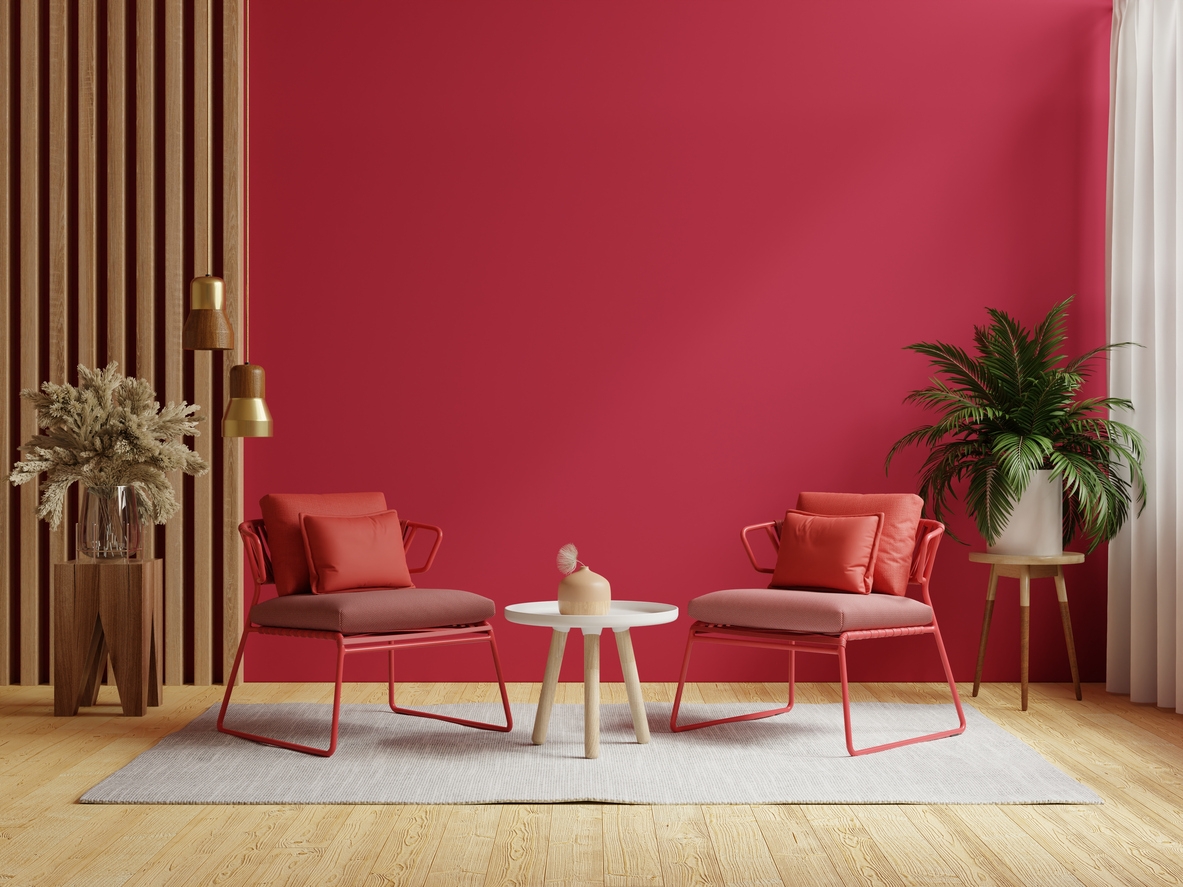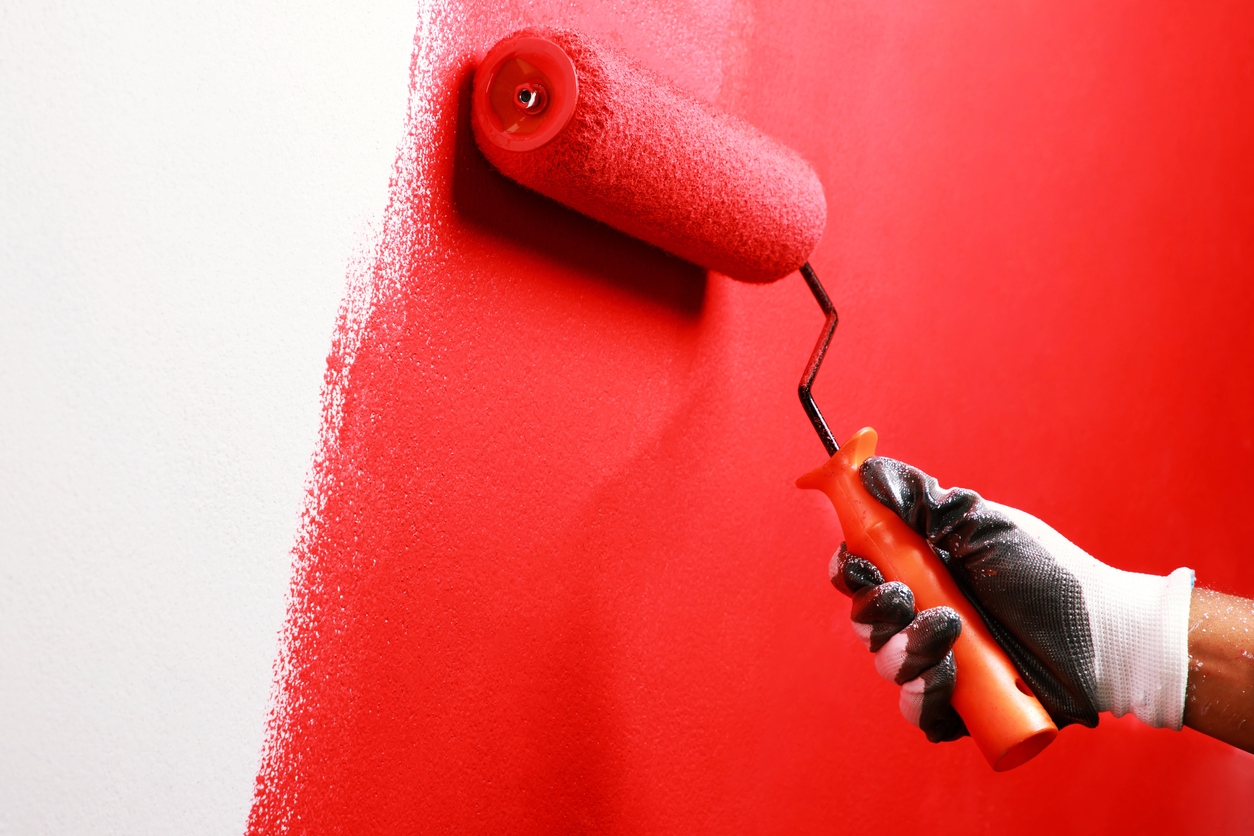Red paint is a powerful tool in interior design, especially in business environments. Its bold and vibrant hue can dramatically alter the ambiance of a room. This article explores how using red paint affects different types of rooms within a business, from offices and conference rooms to lounges and retail spaces.
We’ll look at the psychological impacts, the mood it sets, and how it can influence both employees and customers. Understanding these effects can help you make informed decisions about incorporating red into your San Ramon, CA area business’s interior design.
Red in Reception Areas
Reception areas serve as the first point of contact for visitors and clients, making their design crucial for setting the tone of your business. Using red paint in these spaces can create a dynamic and memorable impression.
Creating a Bold First Impression
A reception area painted in red immediately grabs attention. This vibrant color can make a strong statement about your business, signaling that it is bold, energetic, and unafraid to stand out. The use of red can leave a lasting impact on visitors, making them more likely to remember their experience.
Conveying Energy and Confidence
Red is often associated with energy, passion, and confidence. Incorporating it into your reception area can convey these qualities to your clients and visitors. It can create an atmosphere that feels lively and welcoming, reflecting the dynamism and assertiveness of your business.
Examples and Tips for Effective Use
- Accent Walls: Instead of painting the entire reception area red, consider using it on one feature wall. This creates a focal point without overwhelming the space.
- Furniture and Decor: Integrate red through furniture, artwork, or decorative items. Red chairs, rugs, or lamps can add pops of color that enhance the overall design.
- Balancing with Neutrals: Pair red with neutral colors like white, gray, or beige to balance its intensity. This can prevent the space from feeling too overpowering.
- Lighting: Ensure your lighting complements the red tones. Warm lighting can enhance the richness of the color, while cool lighting can create a striking contrast.
Using red paint in your reception area can be an effective way to make a bold and confident statement. With thoughtful application, it can create a vibrant and welcoming environment that reflects the energy of your business.
Red in Conference Rooms
Conference rooms are vital spaces for meetings, brainstorming sessions, and decision-making. The color scheme in these rooms can significantly impact the atmosphere and effectiveness of discussions. Red can be an excellent choice for stimulating conversation and creativity when used thoughtfully.
Stimulating Discussion and Creativity
Red is known for its ability to stimulate the mind and energize those in its presence. In a conference room, red can encourage lively discussions and creative thinking. It can help to break the ice and promote a dynamic exchange of ideas, making meetings more productive and engaging. You may need to consider wallpaper removal and other renovations to get the desired look for your space.
Balancing Red with Neutral Tones
While red can be invigorating, too much of it can be overwhelming and distracting. To achieve a harmonious environment, balance red with neutral tones such as white, gray, or beige. This combination can create a visually appealing space that harnesses the energy of red without overpowering the room. Neutrals can also provide a calming backdrop that allows the red accents to stand out more effectively.
Considerations for Intensity and Placement
- Intensity: Choose the right shade of red to suit the purpose of the room. A bright, vivid red can be very stimulating but might be too intense for long meetings. A darker, muted red can provide warmth and energy without being overwhelming.
- Placement: Consider where to apply red in the conference room. Accent walls, particularly those in the line of sight of participants, can create a focal point that energizes the room. Alternatively, using red in furniture, such as chairs or cushions, can add splashes of color without dominating the space.
- Balance with Decor: Integrate red through artwork, plants, or decorative items. These can provide visual interest and stimulate creativity without requiring large swathes of red paint.
Using red in conference rooms can enhance the atmosphere, making it conducive to discussion and creativity. By balancing it with neutral tones and carefully considering its intensity and placement, you can create an environment that is both stimulating and welcoming.
Red in Breakrooms and Cafeterias
Breakrooms and cafeterias are essential spaces for employees to relax, recharge, and socialize. The use of red paint in these areas can significantly influence the atmosphere and behaviors of those who use them. Here’s how red can be effectively utilized in these settings.
Enhancing Appetite and Social Interaction
Red is a color often associated with stimulating appetite and encouraging social interaction. It can make food appear more appealing and create a warm, inviting environment where employees feel more inclined to engage in conversation. This can enhance the overall dining experience, making breaks more enjoyable and fostering a sense of community among employees.
Using Red to Create a Lively Atmosphere
Incorporating red into breakrooms and cafeterias can create a vibrant and energetic atmosphere. This can be particularly beneficial in spaces where employees come to unwind and recharge. A lively atmosphere can uplift moods and provide a refreshing change from the typical work environment, making breaks more rejuvenating.
Potential Downsides and How to Mitigate Them
- Overstimulation: While red can be invigorating, too much of it can lead to overstimulation, causing restlessness or discomfort. To mitigate this, use red in moderation. Consider using red accents rather than painting entire walls. This can provide the benefits of red without overwhelming the senses.
- Balancing with Soothing Colors: Pair red with more soothing colors like soft greens, blues, or neutrals. This balance can help tone down the intensity of red, creating a more relaxing environment while still maintaining a lively feel.
- Strategic Placement: Be mindful of where you apply red. For instance, using red on one wall or in specific areas, such as seating arrangements or décor, can help direct the energy without overpowering the entire space. Avoid placing too much red in areas meant for rest, such as near lounge chairs or relaxation corners.
By thoughtfully incorporating red into breakrooms and cafeterias, you can enhance the dining experience and promote social interaction. Balancing red with other colors and strategically placing it can help mitigate potential downsides, creating a space that is both lively and comfortable.
Red in Workspaces and Offices
The color scheme in workspaces and offices can significantly influence productivity, focus, and overall work atmosphere. Red, when used correctly, can be a powerful color in these settings. Here’s how red can impact workspaces and how to use it effectively.
Impact on Productivity and Focus
Red is a stimulating color that can boost energy levels and increase alertness. This can be beneficial in work environments where high energy and focus are required. Incorporating red into a workspace can help employees stay motivated and attentive, potentially enhancing overall productivity. However, its stimulating properties mean that it should be used strategically to avoid causing distractions.
Suitable Shades and Accent Use
- Shades of Red: The intensity of red can vary significantly with different shades. Bright reds can create a sense of urgency and dynamism, while darker, muted reds can provide a warm, stable, and comforting environment. Choosing the right shade depends on the nature of the work and the desired atmosphere.
- Accent Use: Instead of painting entire walls red, consider using it as an accent color. This can be achieved through furniture, such as chairs or desks, or decorative elements like artwork, rugs, or lamps. Red accents can provide the benefits of the color without overwhelming the space, maintaining a balance that promotes productivity without distraction.
Avoiding Overstimulation and Stress
- Balanced Color Scheme: To prevent overstimulation, balance red with neutral or cooler colors like white, gray, or blue. These colors can help create a calming backdrop that allows red accents to energize without overwhelming the senses.
- Strategic Placement: Be mindful of where red is used in the workspace. For example, incorporating red in areas where brainstorming and creative thinking occur can enhance these activities, while avoiding too much red in areas meant for focused, solitary work can help maintain concentration.
- Subtle Integration: Use red in subtle ways, such as through office supplies, plants with red flowers, or small decor items. These touches can invigorate the space without causing stress or distraction.
By carefully selecting suitable shades of red and using it as an accent, you can create a workspace that enhances productivity and focus. Balancing red with other colors and placing it strategically will help avoid overstimulation and maintain a harmonious work environment.
Red in Retail Spaces
Red paint can be a powerful tool for attracting customers and driving sales in retail spaces. Its vibrant and eye-catching nature makes it an excellent choice for creating a dynamic shopping environment. Here’s how red can be effectively used in retail spaces.
Drawing Attention and Driving Sales
Red is a color that naturally draws attention. In a retail setting, this can be used to highlight key products, sales, or promotional areas. The stimulating properties of red can create a sense of urgency, encouraging customers to make quicker purchasing decisions. Studies have shown that red can increase heart rates and create excitement, which can translate into increased sales.
Strategic Placement for Maximum Impact
- Entrance and Signage: Using red at the entrance or on signage can attract customers into the store. A red storefront or sign can stand out from competitors and draw foot traffic.
- Highlighting Promotions: Use red to highlight special offers or promotional items. This can be done through red tags, banners, or displays. Placing red around sale items can make them more noticeable and appealing.
- Focal Points: Create focal points within the store using red. This could be a red feature wall behind a display or red shelving units that guide customers’ attention to specific products.
Ensuring Brand Consistency and Appeal
- Brand Colors: If red is part of your brand’s color palette, ensure it is used consistently throughout the store to reinforce brand identity. This can help create a cohesive and recognizable shopping experience.
- Complementary Colors: Pair red with complementary colors that align with your brand’s aesthetic. For example, pairing red with white or black can create a classic and sophisticated look, while red with yellow or orange can create a more energetic and youthful vibe.
- Moderation: While red is effective, it should be used in moderation to avoid overwhelming customers. Too much red can create a chaotic environment, so balance it with neutral or cooler tones to maintain a pleasant shopping atmosphere.
By strategically placing red in retail spaces, you can draw attention to key areas and drive sales effectively. Ensuring that the use of red aligns with your brand identity and is balanced with other colors will create an appealing and cohesive shopping experience.
General Tips for Using Red Paint in Business Spaces
Using red paint effectively in various business environments requires thoughtful consideration of its psychological impact and the overall design scheme. Here are some general tips to help you incorporate red paint successfully.
Understand the Psychological Impact
- Stimulating and Energizing: Red is known to stimulate the mind and increase energy levels. Use it in spaces where you want to promote activity and engagement, such as reception areas, conference rooms, and retail spaces.
- Appetite and Interaction: Red can enhance appetite and encourage social interaction, making it ideal for breakrooms, cafeterias, and dining areas.
Choose the Right Shade
- Bright Reds: These can create a sense of urgency and excitement. They are suitable for areas where you want to draw attention or stimulate quick decision-making.
- Muted Reds: Darker or more subdued shades of red can create a warm, stable, and professional environment suitable for workspaces and offices.
Use Red as an Accent
- Accent Walls: Instead of painting an entire room red, consider accent walls to create focal points without overwhelming the space.
- Furniture and Decor: Incorporate red through furniture, artwork, rugs, or accessories. This can add vibrant touches without dominating the overall design.
Balance with Neutrals and Complementary Colors
- Neutral Tones: Pair red with neutral colors like white, gray, or beige to balance its intensity. This can help prevent the space from feeling too overpowering.
- Complementary Colors: Use colors that complement red, such as green, blue, or even gold, to create a harmonious and visually appealing environment.
Consider the Purpose of the Space
- Reception Areas: Use red to create a bold first impression and convey energy and confidence.
- Conference Rooms: Stimulate discussion and creativity by using red in moderation and balancing it with neutral tones.
- Breakrooms and Cafeterias: Enhance appetite and social interaction with subtle red accents while avoiding overstimulation.
- Workspaces and Offices: Boost productivity and focus with suitable shades of red used as accents and balanced with calming colors.
- Retail Spaces: Draw attention and drive sales with strategically placed red elements that highlight key products and promotions.
Avoid Overstimulation
- Moderation: Use red in moderation to avoid overwhelming or stressing those in the space. Too much red can be distracting and uncomfortable.
- Strategic Placement: Be mindful of where you apply red. Use it in areas where its stimulating effects will be most beneficial, and avoid overuse in areas meant for relaxation or focused work.
By understanding the psychological impact of red, choosing the right shades, and using it strategically, you can create business spaces that are both visually appealing and functionally effective. Balance is key to harnessing the power of red without overwhelming the environment.
Conclusion
Incorporating red paint into different areas of your business can have a profound impact on the atmosphere, productivity, and customer experience. Whether it’s making a bold first impression in reception areas, stimulating creativity in conference rooms, enhancing social interactions in breakrooms, boosting productivity in workspaces, or driving sales in retail spaces, red can be a powerful tool when used thoughtfully and strategically. By balancing red with complementary colors and considering the specific needs of each space, you can create an environment that is both dynamic and welcoming.
For expert advice and professional painting services, contact Custom Painting, Inc. at 925-866-9610 or through our contact form. Let us help you transform your business spaces with the perfect touch of red.



